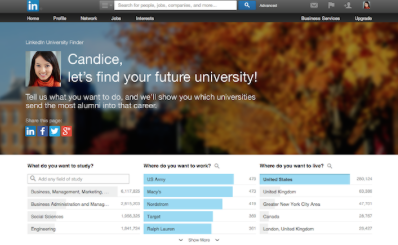.png) Today, LinkedIn has launched a new set of features aimed at college-bound students. The three new tools have been dubbed Decision Boards, University Outcome Rankings, and University Finder, all aimed to help students decide where to apply, what to study, and who might have some useful advice to help them out. Although LinkedIn has recently been amping up its development on premium membership and advertising, the new features will not be a part of that campaign: the new tools are free for all individuals.
Today, LinkedIn has launched a new set of features aimed at college-bound students. The three new tools have been dubbed Decision Boards, University Outcome Rankings, and University Finder, all aimed to help students decide where to apply, what to study, and who might have some useful advice to help them out. Although LinkedIn has recently been amping up its development on premium membership and advertising, the new features will not be a part of that campaign: the new tools are free for all individuals.
Decision Boards is an interesting feature that works similar to the app, Belly (an advice/Q&A app created by Twitter alums). Decision Boards will allow users to call on their networks and others for advice on topics such as what schools to look at, which subjects to study, and the like. What LinkedIn hopes students will also use Decision Board for is to “meet” people at their potential schools, before they even arrive there. This would be accomplished by users tagging the school in a question, and then engaging with school members, or even other potential students. LinkedIn has boldly labelled Decision Boards as “a first-of-its-kind social decision making tool.”
The second tool, University’s Outcome Rankings is the big data features. Million of alumni profiles across the board are collegcted, analysed, and then, based on those profiles, rankings are produced of how schools fare based around careers and (presumably) the success rate of graduates. The problem, however, is that it only collects data from alumni on LinkedIn, which might end up seriously under representing some schools, professions, and geographies. That being said, it could very well be a big draw for rising college students when they are considering potential schools.
Finally, University Finder, the third tool, is pretty much a search tool that “personalizes” the results. The tool uses parameters like your intended career, or even where you might like to work, and then matches you up with institutions it finds “compatible” to your preferences. It is highly likely that this tool will produce mainly predictable corrections (i.e. computer science major and Stanford University: work at Google), but only time will tell if less obvious suggestions will surface.
It is a smart move by LinkedIn as they look to broaden their number of users by appealing to the student-demographic. In addition, it is very possible that with these new features, LinkedIn could become the bridge for students as they transition from studying at school to entering the working world. As LinkedIn seeks to differentiate itself among the many existing social networks, it will be interesting to see both how the new features are received, as well as whether other social networks produce similar services to further their appeal to the highly coveted audience of higher education.
Source: TechCrunch


